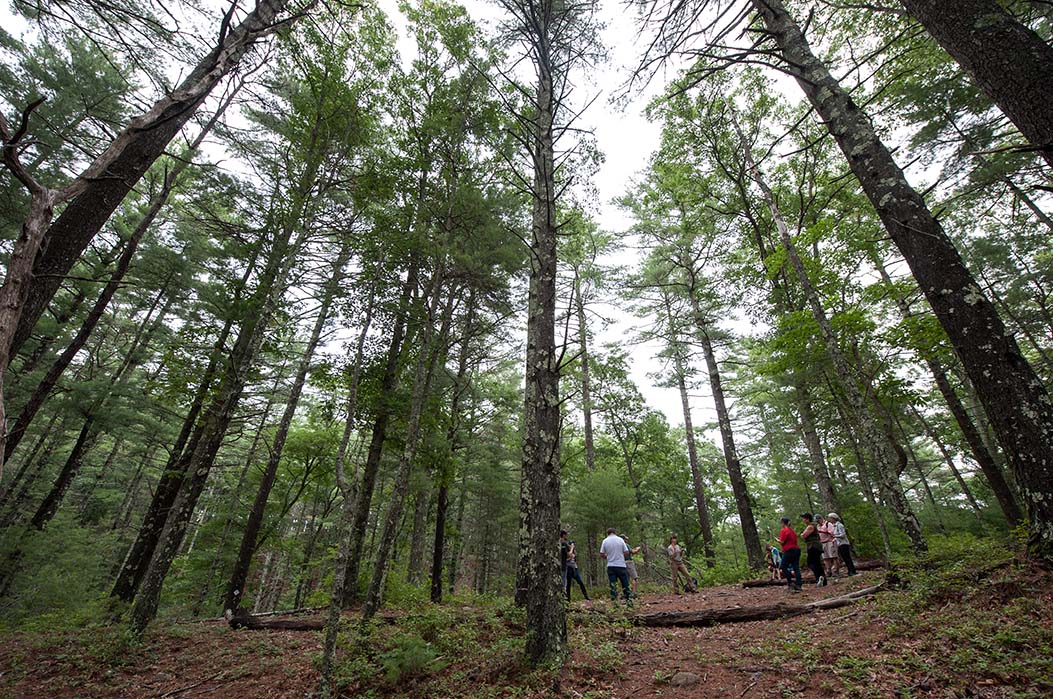PETERSHAM, Mass.
,
June 21, 2023
(press release)
–
The first-ever, comprehensive study of the region’s forever wild forests makes a case to accelerate their protection Addressing the global crises of climate change, biodiversity loss, and the related threats to human health and safety requires coordinated international goals that translate into local action. The United States, which has joined the multi-national effort to conserve 30% of the Earth’s land and waters by 2030 (known as 30×30), must rely on areas of the country, like New England, that have the greatest potential for land conservation. A new study released today shows why New England, with some of the most intact temperate forest on the planet, is uniquely positioned to lead the nation’s participation in this global effort while also securing the region’s future. The study, Wildlands in New England: Past, Present, and Future, provides a baseline and a path forward for policy makers, landowners, conservationists, and citizens to accelerate Wildlands conservation — permanently protecting the forests, wetlands, meadows and other areas from development and active management while allowing natural processes to unfold with minimal human interference. The report from Wildlands, Woodlands, Farmlands & Communities (WWF&C) partners Harvard Forest, Highstead Foundation, and the Northeast Wilderness Trust shows that while 81 percent of New England is forested, only 3.3 percent has been permanently protected as Wildlands. This significant gap creates an urgent call to action for advancing Wildlands protection as part of an integrated approach to conservation that also includes forests managed for wood products, natural spaces for recreation and renewal, and farmlands that produce local food — all existing among communities that rely on the health and beauty of the land that they call home. Wildlands are “forever-wild” places, offering numerous benefits that increase with time. These include sequestering and storing carbon, preserving wildlife habitats, supporting biodiversity and ecological complexity, providing clean air and water, and offering spaces for spiritual and physical renewal. Wild places also have intrinsic value—they simply have a right to exist and thrive. Vermont State Representative Amy Sheldon offers that “Integrating wildland conservation with human communities will not only make our cities and villages resilient to climate change and supportive of biodiversity restoration and conservation, but also enjoyable places to live. Understanding where we have conserved wildlands is an important first step toward making strategic investments in conservation to support these multiple goals.” Wildlands in New England fills a critical knowledge gap by providing an inventory of the location, characteristics, and protection status of all 1.3 million acres of Wildlands across the six New England states. This report is the first to map and characterize all Wildlands across any region in the United States. It includes: The Time to Build a Thriving Wildlands Network is Now With mounting pressures caused by climate change and development, the window is closing to assemble a thriving Wildland infrastructure that supports nature and society within and beyond New England. Given the ecological diversity of New England landscapes and their long history of agricultural and industrial use, the report’s authors advocate for incorporating Wildlands conservation into integrated land management strategies at the local, state, and regional levels. “From Acadia National Park, Baxter State Park, and the Wilderness areas in the White and Green Mountains to the state reserves and forever-wild easements on private lands — a thriving, diverse and much more expansive network of Wildlands is vital for counteracting the global crises of climate change, biodiversity loss, and their impact on human welfare,” said report co-author David Foster, Director Emeritus of the Harvard Forest and former president of the Highstead Foundation. “Striking a balance between the land we don’t actively manage and the land we do actively manage for forest and agricultural products is so important. We’re not saying it all needs to be Wildland, but the balance is currently off,” said report co-author Liz Thompson, a Vermont-based ecologist with over 40 years of experience. The authors also highlight the need to strengthen existing Wildlands and increase their protection in perpetuity. Wildlands are protected through mechanisms of variable strength, ranging from federal and state statutes to deed restrictions and local administrative decisions. Self-oversight, the weakest level of protection, is involved in over a third (35%) of all Wildland properties, many of which are state-owned. The pace of Wildland conservation in New England has increased greatly over the last two decades when more than 660,000 acres were protected, yet the region is still far from the WWF&C goal of protecting at least 10% of the region as Wildlands. New England has a unique history of rewilding of areas previously cleared for logging and agriculture, making the authors hopeful that the report can provide the guidance communities need to build a robust Wildlands network. “Wildlands can exist anywhere nature is provided the freedom to be self-willed and to evolve naturally, whether it be a 10-acre suburban parcel or a 10,000-acre parcel in northern New England. It hinges simply on the decisions and commitment that people make,” observed study co-author Jon Leibowitz, Executive Director of the Northeast Wilderness Trust. The Wildlands designated today may not look like the images of old growth forests that the term conjures, but the hundreds of Wildland sites throughout New England serve as a reminder that with time and protection, they will.
* All content is copyrighted by Industry Intelligence, or the original respective author or source. You may not recirculate, redistrubte or publish the analysis and presentation included in the service without Industry Intelligence's prior written consent. Please review our terms of use.






